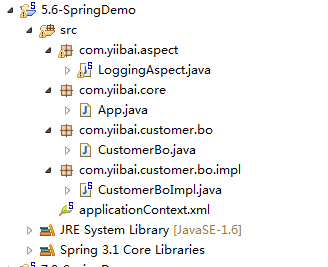Spring AOP+AspectJ註解範例
在本教學中,我們將向你展示如何將AspectJ註解整合到Spring AOP框架。在這個Spring AOP+ AspectJ 範例中,讓您輕鬆實現攔截方法。
常見AspectJ的註解:
- @Before – 方法執行前執行
- @After – 執行在方法返回結果後
- @AfterReturning – 執行在方法返回一個結果後,在攔截器返回結果。
- @AfterThrowing – 執行方法在丟擲異常後,
- @Around – 圍繞方法執行執行,結合以上這三個通知。
注意
Spring AOP 中沒有 AspectJ 支援,請閱讀 內建 Spring AOP 例子。
1. 目錄結構
看到這個例子的目錄結構。


2. Spring Beans
普通 bean 中有幾個方法,後來通過 AspectJ 註解攔截。
package com.yiibai.customer.bo;
public interface CustomerBo {
void addCustomer();
String addCustomerReturnValue();
void addCustomerThrowException() throws Exception;
void addCustomerAround(String name);
}
package com.yiibai.customer.bo.impl;
import com.yiibai.customer.bo.CustomerBo;
public class CustomerBoImpl implements CustomerBo {
public void addCustomer(){
System.out.println("addCustomer() is running ");
}
public String addCustomerReturnValue(){
System.out.println("addCustomerReturnValue() is running ");
return "abc";
}
public void addCustomerThrowException() throws Exception {
System.out.println("addCustomerThrowException() is running ");
throw new Exception("Generic Error");
}
public void addCustomerAround(String name){
System.out.println("addCustomerAround() is running, args : " + name);
}
}
4. 啟用AspectJ
在 Spring 組態檔案,把「<aop:aspectj-autoproxy />」,並定義Aspect(攔截)和普通的bean。
File : applicationContext.xml
<beans xmlns="http://www.springframework.org/schema/beans" xmlns:xsi="http://www.w3.org/2001/XMLSchema-instance" xmlns:aop="http://www.springframework.org/schema/aop" xsi:schemaLocation="http://www.springframework.org/schema/beans http://www.springframework.org/schema/beans/spring-beans-3.0.xsd http://www.springframework.org/schema/aop http://www.springframework.org/schema/aop/spring-aop-3.0.xsd "> <aop:aspectj-autoproxy /> <bean id="customerBo" class="com.yiibai.customer.bo.impl.CustomerBoImpl" /> <!-- Aspect --> <bean id="logAspect" class="com.yiibai.aspect.LoggingAspect" /> </beans>
4. AspectJ @Before
在下面例子中,logBefore()方法將在 customerBo介面的 addCustomer()方法的執行之前被執行。
AspectJ的「切入點」是用來宣告哪種方法將被攔截,應該參考Spring AOP切入點指南,支援切入點表示式的完整列表。
File : LoggingAspect.java
package com.yiibai.aspect;
import org.aspectj.lang.JoinYiibai;
import org.aspectj.lang.annotation.Aspect;
import org.aspectj.lang.annotation.Before;
@Aspect
public class LoggingAspect {
@Before("execution(* com.yiibai.customer.bo.CustomerBo.addCustomer(..))")
public void logBefore(JoinYiibai joinYiibai) {
System.out.println("logBefore() is running!");
System.out.println("hijacked : " + joinYiibai.getSignature().getName());
System.out.println("******");
}
}
執行
CustomerBo customer = (CustomerBo) appContext.getBean("customerBo");
customer.addCustomer();
輸出結果
logBefore() is running! hijacked : addCustomer ****** addCustomer() is running
5. AspectJ @After
在下面例子中,logAfter()方法將在 customerBo 介面的 addCustomer()方法的執行之後執行。
File : LoggingAspect.java
package com.yiibai.aspect;
import org.aspectj.lang.JoinYiibai;
import org.aspectj.lang.annotation.Aspect;
import org.aspectj.lang.annotation.After;
@Aspect
public class LoggingAspect {
@After("execution(* com.yiibai.customer.bo.CustomerBo.addCustomer(..))")
public void logAfter(JoinYiibai joinYiibai) {
System.out.println("logAfter() is running!");
System.out.println("hijacked : " + joinYiibai.getSignature().getName());
System.out.println("******");
}
}
執行它
CustomerBo customer = (CustomerBo) appContext.getBean("customerBo");
customer.addCustomer();
輸出結果
addCustomer() is running logAfter() is running! hijacked : addCustomer ******
6. AspectJ @AfterReturning
在下面例子中,logAfterReturning()方法將在 customerBo 介面的addCustomerReturnValue()方法執行之後執行。此外,還可以擷取返回的值使用「returning」屬性。
要擷取返回的值,對「returning」屬性(結果)的值必須用相同的方法引數(結果)。
File : LoggingAspect.java
package com.yiibai.aspect;
import org.aspectj.lang.JoinYiibai;
import org.aspectj.lang.annotation.Aspect;
import org.aspectj.lang.annotation.AfterReturning;
@Aspect
public class LoggingAspect {
@AfterReturning(
pointcut = "execution(* com.yiibai.customer.bo.CustomerBo.addCustomerReturnValue(..))",
returning= "result")
public void logAfterReturning(JoinYiibai joinYiibai, Object result) {
System.out.println("logAfterReturning() is running!");
System.out.println("hijacked : " + joinYiibai.getSignature().getName());
System.out.println("Method returned value is : " + result);
System.out.println("******");
}
}
執行它
CustomerBo customer = (CustomerBo) appContext.getBean("customerBo");
customer.addCustomerReturnValue();
輸出結果
addCustomerReturnValue() is running logAfterReturning() is running! hijacked : addCustomerReturnValue Method returned value is : abc ******
7. AspectJ @AfterReturning
在下面的例子中,如果 customerBo 介面的addCustomerThrowException()方法丟擲異常logAfterThrowing()方法將被執行。
File : LoggingAspect.java
package com.yiibai.aspect;
import org.aspectj.lang.JoinYiibai;
import org.aspectj.lang.annotation.Aspect;
import org.aspectj.lang.annotation.AfterThrowing;
@Aspect
public class LoggingAspect {
@AfterThrowing(
pointcut = "execution(* com.yiibai.customer.bo.CustomerBo.addCustomerThrowException(..))",
throwing= "error")
public void logAfterThrowing(JoinYiibai joinYiibai, Throwable error) {
System.out.println("logAfterThrowing() is running!");
System.out.println("hijacked : " + joinYiibai.getSignature().getName());
System.out.println("Exception : " + error);
System.out.println("******");
}
}
執行它
CustomerBo customer = (CustomerBo) appContext.getBean("customerBo");
customer.addCustomerThrowException();
輸出結果
addCustomerThrowException() is running logAfterThrowing() is running! hijacked : addCustomerThrowException Exception : java.lang.Exception: Generic Error ****** Exception in thread "main" java.lang.Exception: Generic Error //...
8. AspectJ @Around
在下面例子中,logAround()方法將在customerBo介面的addCustomerAround()方法執行之前執行, 必須定義「joinYiibai.proceed();」 控制何時攔截器返回控制到原來的addCustomerAround()方法。
File : LoggingAspect.java
package com.yiibai.aspect;
import org.aspectj.lang.ProceedingJoinYiibai;
import org.aspectj.lang.annotation.Aspect;
import org.aspectj.lang.annotation.Around;
@Aspect
public class LoggingAspect {
@Around("execution(* com.yiibai.customer.bo.CustomerBo.addCustomerAround(..))")
public void logAround(ProceedingJoinYiibai joinYiibai) throws Throwable {
System.out.println("logAround() is running!");
System.out.println("hijacked method : " + joinYiibai.getSignature().getName());
System.out.println("hijacked arguments : " + Arrays.toString(joinYiibai.getArgs()));
System.out.println("Around before is running!");
joinYiibai.proceed(); //continue on the intercepted method
System.out.println("Around after is running!");
System.out.println("******");
}
}
執行它
CustomerBo customer = (CustomerBo) appContext.getBean("customerBo");
customer.addCustomerAround("yiibai");
輸出結果
logAround() is running! hijacked method : addCustomerAround hijacked arguments : [yiibai] Around before is running! addCustomerAround() is running, args : yiibai Around after is running! ******
總結
它總是建議採用最少 AspectJ 註解。這是關於Spring AspectJ 的一篇相當長的文章。進一步的解釋和例子,請存取下面的參考連結。
下載原始碼 – http://pan.baidu.com/s/1boo4f9P